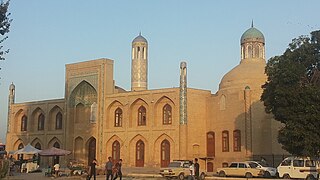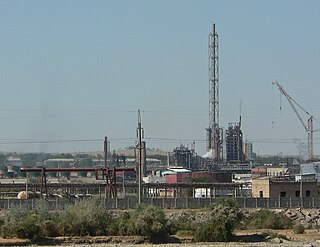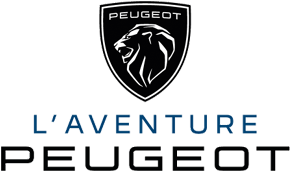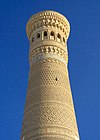
The Reynolds-Alberta Museum is an agricultural, industrial, and transportation museum in Wetaskiwin, Alberta, Canada. The museum is situated on an 89-hectare (220-acre) property containing the main museum building, an aviation display hangar, and its storage facility.

Namangan Region is one of the regions of Uzbekistan, located in the southern part of the Fergana Valley in far eastern part of the country. It is on the right bank of Syr Darya River and borders with Kyrgyzstan, Tajikistan, Tashkent Region, Fergana Region, and Andijan Region. It covers an area of 7,440 km2. The population is estimated to be 2,931,056 (2022), with 35% of the population living in rural areas.

Chirchiq, also spelled as Chirchik, is a district-level city in Tashkent Region, Uzbekistan. It is about 32 km northeast of Tashkent, along the river Chirchiq. Chirchiq lies in the Chatkal Mountains. The population of Chirchiq as of 2021 is approximately 162,800.
The University of World Economy and Diplomacy is located in Tashkent, the capital of Uzbekistan. It was founded on September 23, 1992, by the decree of the President Karimov to train future leaders of the country.

Tashkent University of Information Technologies named after Muhammad ibn Musa al-Khwarizmi often abbreviated as ТАТU or TUIT is one of the largest universities in Uzbekistan, located in its capital Tashkent. Tashkent University of Information Technologies was in 1955 founded as Tashkent Electro Technical Institute of Communication and it was the major and only producer of communication engineers for the Central Asian region. Today, it is one of the major universities to nurture ICT talent in Uzbekistan. The university was named after Al-Khwarizmi by a presidential resolution to further boost its role within the nation and abroad.

Tashkent State University of Economics is one of the largest business schools in Central Asia. It was formerly known as the Tashkent Institute of Economics.

National University of Uzbekistan is a public research university located in Tashkent, Uzbekistan. NUUz is the oldest and largest university in Uzbekistan.

The Musée de l'Aventure Peugeot is a historical museum devoted to the Peugeot automobile business. The museum was founded by members of the Peugeot family, opening in 1988 across the road from the company's huge industrial site at Sochaux.
Tashkent State Transport University (TSTU) is a university in Uzbekistan.

Inha University in Tashkent or IUT is a branch of the Korean Inha University in Tashkent, Uzbekistan. Inha University in Tashkent has two departments - School of Computer and Information Engineering, and the School of Logistics.
Tashkent State Agrarian University or TSAU is an agricultural university located in Tashkent, Uzbekistan.
The Tashkent Institute of Irrigation and Agricultural Mechanization Engineers (TIIAME), formerly Tashkent Institute of Irrigation and Melioration (TIIME) is a university in Central Asia, which works for the development of the water industry, and supplies the country with professionals in this field. Tashkent Institute of Irrigation and Agricultural Mechanization Engineers is located in the Republic of Uzbekistan, Tashkent city, Kari Niyozov street, 39-house.

Tashkent State Technical University (TSTU) is one of the oldest universities in Uzbekistan. Currently, the university consists of 6 faculties, and prepares highly skilled professionals in technical and engineering fields. For this year, it is estimated to run 56 departments with over 10 746 students, who are taught by 6 academicians of the Academy of Sciences of Uzbekistan, 74 doctors of sciences and 314 candidates of sciences.
The Tashkent Automobile and Road Construction Institute was established in Tashkent, Uzbekistan to meet the high demands for professionals in the transportation and automobile fields.

The Museum of Geology in Tashkent, Uzbekistan is a geology museum that shows and represents the wealth of mineral and geological resources in Uzbekistan, including valuable stones, minerals and archaeological and paleontological findings.
The Uzbekistan State Museum of Nature is the oldest museum operating in Uzbekistan. The museum's main purpose is to show the natural beauty of Uzbekistan and to help protect its environment. The museum features chronologically-ordered exhibits and seeks to educate visitors about Uzbekistan's geography through time.
Art Gallery of Uzbekistan is established in Tashkent city, after the Independence of Republic Uzbekistan, and became one of the most visited modern museums of local people in Uzbekistan.
The Museum of Health Care of Uzbekistan is in Uzbekistan. It was established in order to contribute information about the medicine and hygiene among the Uzbek people in an interesting way.
Tashkent Planetarium is one of the newest constructions in Uzbekistan, and is visited by local people and tourists. Tashkent Planetarium provides visitors with the opportunity to look at outer space, even in the morning, and enlarge their knowledge about the cosmos and the whole universe.












